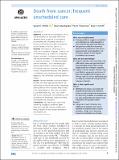Files in this item
Death from cancer : frequent unscheduled care
Item metadata
| dc.contributor.author | Mills, Sarah E E | |
| dc.contributor.author | Buchanan, Deans | |
| dc.contributor.author | Donnan, Peter T | |
| dc.contributor.author | Smith, Blair H | |
| dc.date.accessioned | 2022-11-16T16:30:03Z | |
| dc.date.available | 2022-11-16T16:30:03Z | |
| dc.date.issued | 2022-03-29 | |
| dc.identifier | 282169757 | |
| dc.identifier | 39182d91-08cd-4e63-b5ab-c170ced8634d | |
| dc.identifier | 35351803 | |
| dc.identifier.citation | Mills , S E E , Buchanan , D , Donnan , P T & Smith , B H 2022 , ' Death from cancer : frequent unscheduled care ' , BMJ Supportive & Palliative Care , vol. Early view . https://doi.org/10.1136/bmjspcare-2021-003448 | en |
| dc.identifier.issn | 2045-435X | |
| dc.identifier.uri | https://hdl.handle.net/10023/26412 | |
| dc.description | Funding: SEEM is funded through a Clinical Academic Fellowship from the Chief Scientist Office (CAF_17_06). Funding for data extraction and storage was through PATCH Scotland and Tayside Oncology Research Foundation Research Grants. | en |
| dc.description.abstract | OBJECTIVE : To examine the demographic, clinical, and temporal factors associated with cancer decedents being a frequent or very frequent unscheduled care (GP-general practice Out-Of-Hours (GPOOH) and Accident & Emergency (A&E)) attender, in their last year of life. METHODS : Retrospective cohort study, of all 2443 cancer decedents in Tayside, Scotland, over 30- months period up to 06/2015, comparing frequent attenders (5-9 attendances/year) and very frequent attenders (≥10 attendances/year) to infrequent attenders (1-4 attendances/year) and non-attenders. Clinical and demographic datasets were linked to routinely-collected clinical data using the Community Health Index number. Anonymised linked data were analysed in SafeHaven, using binary/multinomial logistic regression, and Generalised Estimating Equations analysis. RESULTS : Frequent attenders were more likely to be older, and have upper gastrointestinal (GI), haematological, breast and ovarian malignancies, and less likely to live in accessible areas or have a late cancer diagnosis. They were more likely to use GPOOH than A&E, less likely to have face-to-face unscheduled care attendances, and less likely to be admitted to hospital following unscheduled care attendance. CONCLUSIONS : Age, cancer type, accessibility and timing of diagnosis relative to death were associated with increased likelihood of being a frequent or very frequent attender at unscheduled care. | |
| dc.format.extent | 6 | |
| dc.format.extent | 247399 | |
| dc.language.iso | eng | |
| dc.relation.ispartof | BMJ Supportive & Palliative Care | en |
| dc.subject | RC0254 Neoplasms. Tumors. Oncology (including Cancer) | en |
| dc.subject | 3rd-DAS | en |
| dc.subject | SDG 3 - Good Health and Well-being | en |
| dc.subject | MCC | en |
| dc.subject.lcc | RC0254 | en |
| dc.title | Death from cancer : frequent unscheduled care | en |
| dc.type | Journal article | en |
| dc.contributor.institution | University of St Andrews. Population and Behavioural Science Division | en |
| dc.contributor.institution | University of St Andrews. School of Medicine | en |
| dc.identifier.doi | 10.1136/bmjspcare-2021-003448 | |
| dc.description.status | Peer reviewed | en |
This item appears in the following Collection(s)
Items in the St Andrews Research Repository are protected by copyright, with all rights reserved, unless otherwise indicated.

